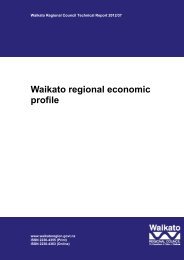Spatial distribution and seasonal variation in Undaria pinnatifida ...
Spatial distribution and seasonal variation in Undaria pinnatifida ...
Spatial distribution and seasonal variation in Undaria pinnatifida ...
Create successful ePaper yourself
Turn your PDF publications into a flip-book with our unique Google optimized e-Paper software.
3.1.2. Coastal reef locationsContiguous 50 x 10m transects were run along sections of coast adjacent to all mussel farm locations on the Corom<strong>and</strong>elPen<strong>in</strong>sula. A total of twenty six coastal reef areas were surveyed via SCUBA <strong>and</strong>/or snorkel. In New Zeal<strong>and</strong>, <strong>Undaria</strong>populations that occur on native reef habitats are typically densest from the low <strong>in</strong>tertidal fr<strong>in</strong>ge down to approximatelythree metres (Brown <strong>and</strong> Lamare, 1994; Parsons, 1994; S<strong>in</strong>ner et al, 2000; Stuart, 2004; Russell et al, 2007). Much of thereef adjacent to the farms <strong>in</strong> the western Corom<strong>and</strong>el is relatively shallow, with a s<strong>and</strong>-reef border at depths of less than5m <strong>and</strong> a limited offshore extent of 15-30m. Sampl<strong>in</strong>g was concentrated on the shallow-subtidal marg<strong>in</strong> of the reef,typically just below the low-tide mark. The depth of the surveys conducted ranged from one to five metres, depend<strong>in</strong>g onhabitat <strong>and</strong> tide levels, with an average depth across the total 244 transects of 2.4m. In the case of the WBMFZ, wherethere is more than five kilometres of adjacent coastl<strong>in</strong>e, five coastal sites were selected where subtidal reef habitatoccurred that could potentially be colonised by <strong>Undaria</strong>. A total of 2250 meters of this adjacent coast was surveyed. Thenature of the benthic environment <strong>and</strong> algal species present was recorded for each 50m transect. The presence of other<strong>in</strong>vasive species was noted.Surveys were carried out between November 22 nd 2011 <strong>and</strong> February 3 rd 2012. To exam<strong>in</strong>e the potential for differences <strong>in</strong>tim<strong>in</strong>g of surveys to <strong>in</strong>fluence the presence or <strong>in</strong>festation level of <strong>Undaria</strong> two sites where <strong>Undaria</strong> was recorded <strong>in</strong>November were revisited <strong>in</strong> February <strong>and</strong> <strong>Undaria</strong> populations were qualitatively compared.3.1.3. Other “high risk” locationsIn order to <strong>in</strong>vestigate the potential spread of <strong>Undaria</strong> by recreational vessels, seven “high risk” sites of <strong>in</strong>terest weresurveyed <strong>in</strong> February 2012. These were comprised of two sw<strong>in</strong>g moor<strong>in</strong>g sites <strong>in</strong> the Corom<strong>and</strong>el Harbour at Takawharebay <strong>and</strong> W<strong>in</strong>dy Po<strong>in</strong>t/Puhi Rare, three boat ramps; Waikawau (Thames coast), Port Charles <strong>and</strong> the Sugarloafrecreational <strong>and</strong> mussel load<strong>in</strong>g ramp at Te Kouma, a set of moor<strong>in</strong>g buoys <strong>in</strong> Kennedy bay <strong>and</strong> the <strong>in</strong>frastructure atHannaford’s Jetty <strong>in</strong> the Corom<strong>and</strong>el Harbour were also surveyed. Boat ramp sites were surveyed via snorkel <strong>and</strong>/orSCUBA, surveyors searched artificial structures <strong>and</strong> surround<strong>in</strong>g coastal reef sites. The sw<strong>in</strong>g moor<strong>in</strong>g site at W<strong>in</strong>dyPo<strong>in</strong>t/Puhe Rare was surveyed via SCUBA, divers <strong>in</strong>spected a r<strong>and</strong>om subset of moor<strong>in</strong>gs <strong>and</strong> mussel barge hulls. Therecreational sw<strong>in</strong>g moor<strong>in</strong>gs at Takawhare Bay were surveyed from kayaks, a r<strong>and</strong>om subset of moor<strong>in</strong>g floats/l<strong>in</strong>es <strong>and</strong>vessel hulls were <strong>in</strong>spected from the surface or moor<strong>in</strong>g floats were lifted out of the water <strong>and</strong> <strong>in</strong>spected aboard thekayaks. The moor<strong>in</strong>g buoys at Kennedy bay were <strong>in</strong>spected <strong>in</strong> a similar manner, by lift<strong>in</strong>g them aboard a d<strong>in</strong>ghy. AtTakawhare Bay 43 out of 120 listed moor<strong>in</strong>gs were surveyed. At Puhi Rare 12 out of the seventy listed moor<strong>in</strong>gs were<strong>in</strong>spected, very poor visibility prevented more <strong>in</strong>spections at this site.3.1.4. Semi-quantitative measurements of <strong>Undaria</strong> abundanceFor each 50m section of mussel l<strong>in</strong>e or coast surveyed the number of <strong>Undaria</strong> plants sighted was placed <strong>in</strong> one of fivecategories, these are shown <strong>in</strong> Table 1:Table 1: <strong>Undaria</strong> <strong>in</strong>festation categoriesCategory Number of plants per 50m Level of Infestation0 0 None (green)1 1-10 Low (orange)2 11-100 Medium (orange)3 101-500 High (red)4 >500 Heavily <strong>in</strong>fested (red)6
















